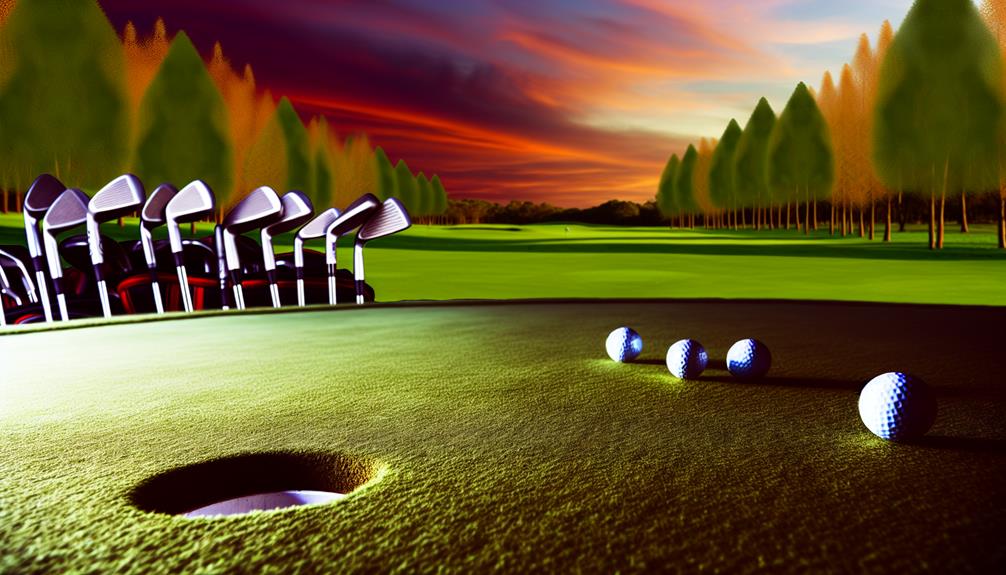Just when you're thinking about upping your golf game, we're here discussing the four best artificial putting greens on golf courses.
You're probably aware that synthetic greens have become a popular choice for many golf enthusiasts and professionals alike, and for good reason. They offer consistent playability, require less maintenance, and can withstand all weather conditions.
But with a multitude of options available, how do you decide which artificial green is the best for you? We'll be comparing the top four choices, analyzing their key features and benefits, to help you make an informed decision.
Stay tuned to find out more.
Unveiling the Top Artificial Putting Greens
In the world of golf, where precision and technique are paramount, you'll find that top-tier artificial putting greens, with their superior quality and exceptional performance, can truly elevate your game. But don't underestimate the installation process; it's no walk in the park. It involves site preparation, base construction, turf installation, and infill application, each step requiring expert knowledge and meticulous execution. Any misstep can lead to an uneven surface or poor drainage, greatly affecting the playability and longevity of the green.
Let's talk numbers: a cost analysis of artificial putting greens versus natural ones. Artificial greens might seem pricier upfront, but they offer more value in the long run. They're durable, require less maintenance, and stand up better to weather conditions. You're not constantly battling with mowing, watering, or pest control, which can run up costs over time with natural greens.
In your pursuit of golfing excellence, the choice is clear. Top-tier artificial greens, while requiring careful installation and a higher initial investment, promise a return in consistent playability and reduced upkeep costs. It's not just a purchase; it's an investment in your game.
Key Features of Ideal Synthetic Greens
When you're choosing synthetic greens, there's a handful of standout features you should be looking for to ensure your investment pays off in performance and durability.
Material Quality sits at the top of the list. High-quality materials not only yield a more realistic look and feel but also stand up better to wear and tear. Ideally, you should opt for a product that's UV-stabilized to resist fading, and one that's non-absorbent to prevent water logging.
Next up are Installation Techniques. Proper installation is absolutely crucial for a synthetic green's performance and longevity. You should ensure the underlying soil is properly compacted and leveled to avoid any future wrinkling or shifting. The synthetic turf should be seamed tightly together and securely fastened to the base.
Also, don't overlook the infill – the material spread over the turf to keep the blades upright. It should be evenly distributed and of the right type to provide optimal ball roll and bounce.
Taking your time to consider these features will lead to a synthetic green that not only enhances your golf game, but also stands the test of time.
Comparing the Top Four Artificial Greens
Now that you're familiar with the essential features of artificial greens, let's delve into a detailed comparison of the top four synthetic putting greens on the market.
First up is the PolyGreen turf. It's quite affordable, making it attractive for those on a budget. However, the installation process can be tricky and may require professional help.
Next is the GreenPro series. It's a bit pricier, but you'll find its installation process easier. The trade-off for the higher price is a more user-friendly experience.
Then we've the TrueRoll product line. It boasts a mid-range price, and its installation process is straightforward. It's an excellent balance of cost and easy setup.
Lastly, the elite ProGreen turf comes at a premium price, reflecting its top-tier quality. Its installation requires professionals, but the superior finish is worth it.
Benefits of Using Artificial Putting Greens
Harnessing the power of artificial putting greens can drastically transform your golfing experience, offering a myriad of benefits that go beyond the scope of traditional natural grass.
In terms of environmental impact, artificial greens are a sustainable choice. They don't require water or fertilizers to maintain their lush appearance, reducing your carbon footprint and conserving precious resources. Furthermore, they prevent the use of harmful chemicals that often seep into groundwater, posing a threat to local ecosystems.
The maintenance requirements for artificial greens are also significantly less than their natural counterparts. You're spared the labor-intensive tasks of mowing, aerating, and weeding. This not only saves you time, but also cuts down on costs associated with equipment and labor. The durability of synthetic greens also means they're less susceptible to wear and tear, ensuring a consistent playing surface year-round.
Moreover, they offer a consistent roll and bounce, replicating the performance of a professional course. This consistency can help improve your putting skills, providing a reliable practice surface no matter the weather.

